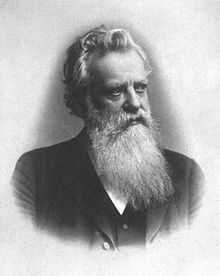Carl Scheibler
| Carl Scheibler | |
|---|---|
 Carl Scheibler | |
| Born |
February 16, 1827 Gemereth/Eupen, Germany |
| Died |
April 2, 1899 (aged 72) Berlin , Germany |
| Nationality | German |
| Fields | sugar, chemistry |
| Alma mater | University of Berlin |
Carl Wilhelm Bernhard Scheibler (16 February 1827 – 2 April 1899) was a German chemist. Scheibler's research focused on sugar, including the technical chemistry of sugar production and the composition of molasses.
Scheibler was born the son of Friedrich August Theodor Scheibler (1788–1864) and Anna Gertrud Eschweiler (1806–1877) in Gemereth/Eupen, at that time a small town close to the Belgian border. He went to school in Aachen and studied chemistry at the University of Berlin. He received his PhD for his work De Wolframiatibus.[1] Scheibler worked with Gustav Werther in Königsberg and from 1858 at the Pommersche Provinzial-Zuckersiederei in Stettin.[2][3][3][4][5][5][6]
In 1866 Scheibler founded the Zuckerchemische und technische Laboratorium (Laboratory for sugar chemistry and technology) in Berlin, which was financed by the Verein der Deutschen Zuckerrübenindustrie (Association of the German Sugar Beet Industry). It was one of the first institutes dedicated to the chemistry of sugar. In 1870 Scheibler became professor at the Gewerbeakademie Berlin and at the University of Agriculture Berlin and he also was a member of the imperial patent office in Berlin between 1877 and 1882.[4][5]
After a conflict with the Verein der Deutschen Zuckerrübenindustrie in 1882, he only worked privately at his institute, but he was able to patent several inventions in that time. For example he helped his relative Carl Johann Heinrich Scheibler invent a fertiliser, and he also improved smokeless powder for Otto von Bismarck in 1888.[4][5]
His most influential patents were based on the technical production of sugar from beets. The crystallisation of sugar from molasses was difficult and therefore the sugar had to be separated from the molasses. In 1863 Scheibler invented the elution method. During his research on molasses he discovered several compounds in molasses, for example betaine, asparaginic acid, glutamic acid, arabinose, arabinic acid, dextran, phosphoglyceride and cholesterol.[4][5]
He improved the strontia saccharate process, in which strontium hydroxide is mixed with the molasses and strontium di-saccharate precipitates and can be separated from the molasses. Prior to World War I the beet sugar industry used 100,000 to 150,000 tons of strontium hydroxide for this process per year.[7]
Scheibler died in Berlin on 2 April 1899.[5]
References
- ↑ "De Wolframiatibus : Dissertatio Inauguralis Chemica". Retrieved 2010-11-09.
- ↑ Elisabeth Nay-Scheibler: Die Geschichte der Familie Scheibler, in: Stiftung Scheibler-Museum Rotes Haus Monschau (Hg), Köln 1994
- ↑ 3.0 3.1 Carl Johann Heinrich Scheibler: Geschichte und Geschlechtsregister der Familie Scheibler, Cologne, 1895
- ↑ 4.0 4.1 4.2 4.3 Degener, P. (1900). "Carl Scheibler". Berichte der deutschen chemischen Gesellschaft 33 (3): 3839. doi:10.1002/cber.190003303200.
- ↑ 5.0 5.1 5.2 5.3 5.4 5.5 Michael Engel (2005) (in German). "Scheibler, Carl Wilhelm Bernhard ". In Neue Deutsche Biographie (NDB). 22. Berlin: Duncker & Humblot. pp. 627 et seq..
- ↑ Liebermann, C. (1899). "Sitzung vom 10. April 1899". Berichte der deutschen chemischen Gesellschaft 32: 981. doi:10.1002/cber.189903201153.
- ↑ Heriot, T. H. P (2008). "strontium saccharate process". Manufacture of Sugar from the Cane and Beet. ISBN 978-1-4437-2504-0.
Further reading
- "Carl Scheibler". Zeitschrift des Vereins der Deutschen Zucker-Industrie N. F. 36: 69 and 75–85. 1899.
- Rudolf Vierhaus: Deutsche Biographische Enzyklopädie, S. 793, 2. Ausgabe, K.G. Saur, München, ISBN 3-598-25030-4
- "Industrial notes". Industrial & Engineering Chemistry 10 (6): 501. 1918. doi:10.1021/ie50102a037.
|